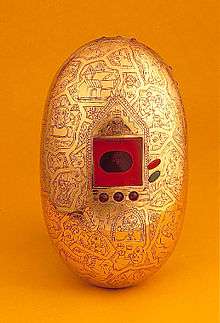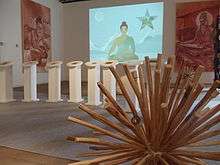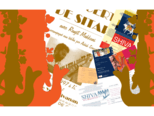Ranjit Makkuni
| Ranjit Makkuni | |
|---|---|
 Ranjit Makkuni in front of his Flute Tree sculpture (2011) | |
| Education | IIT, Kharagpur |
| Alma mater | University of California Los Angeles |
| Website |
www |
Ranjit Makkuni is an international multimedia artist and designer, the honorary director of the design think tank, the Sacred World Research Laboratory,[1] as well as a musician,[2] sitar player,[3] and songwriter.
His multimedia museum works are intersections between traditional and modern art, design and technology, such that the results help both traditional and modern cultures. They are intended to show that the wisdom of traditional communities can positively negate the homogenizing influences of modern technology; and that the intelligence, creativity and sense of freedom afforded by modern design and technology can reciprocally help traditional artists.[4]
His major works are several museum projects: Eternal Gandhi Multimedia Museum,[5] Planet Health Museum,[6] The Goddess and Temples of Music,[7] and The Crossing: Living, Dying and Transformation in Banaras.[8]
Education and research

Ranjit obtained a B.Arch. from IIT, Kharagpur, and a Masters in Design Theory and Methods from University of California Los Angeles (UCLA). He has been a scientific consultant to HP Labs Palo Alto, HP Labs Bangalore, and a member of the Explorer’s club of the Ivrea Institute of Design, Ivrea, Italy.[9] He is a member of the mentoring group of Nehru Memorial Museum, New Delhi, constituted by the Prime Minister of India.[10]
Works done at Xerox Palo Alto Research Center (PARC)
In 1985, Ranjit joined the System Concepts Lab of PARC, becoming part of the group which developed the object-oriented programming language Smalltalk-80 and the world's first graphical user interface.[11] From that base, Ranjit pioneered explorations in computer-aided design (CAD), gesture recognition interfaces, and multimedia applications to develop the Active Learning Project at PARC.[12][13] These have been demonstrated as museum exhibitions in the US, India, Europe and Thailand (see Bibliography - Exhibitions below), transforming people’s perceptions of traditional cultures,and presenting an Asian approach to interaction with computing technology.[14][15][16][17][18]
In 1989, The Electronic Sketchbook of Tibetan Thangka Painting was displayed in the Asian Art Museum of San Francisco.[19] This project represents one of the world's first multimedia applications of any kind[20][21] and a pioneering example of a computer based cultural learning tool.
During 1994-1997, he worked with scholars at the Indira Gandhi National Centre for the Arts, New Delhi, to develop the Gita-Govinda Multimedia Experience,[22] a pioneering demonstration of a physical-virtual multimedia document based on the poet Jayadeva’s 12th century love poem, the Gita Govinda. This project brought the footprints of multimedia computing technology to India.[23][24][25]

Works done at Sacred World Research Laboratory
During 1998-2002, Ranjit conceived and directed The Crossing Project: Living, Dying, and Transformation in Banaras[8][13][26][27][28][29][30][31] which developed a panorama of digital information access devices and technologies personalized by the cultural traditions of Banaras. The project brought together Western Information Access Knowledge systems and Indian notions of 'connection' and interaction based on India’s city of Knowledge, Banaras. The project was a pioneering demonstration of physical computing, and culturally personalized computing hardware and interactions.[32][33][34][35]


During 2003-2005, Ranjit visualized and directed the Eternal Gandhi Multimedia Museum, New Delhi,[36] one of the world’s first digital multimedia museums. Located at the site where Mahatma Gandhi attained martyrdom, the museum preserves the historical events of Gandhiji’s life in digital form but also presents a spectrum of information technology visions inspired by Gandhian thought. The project revives the values by which India obtained freedom; it also redefines those values in order to animate modern products and design. Through a collection of over 50 originally designed works of technology and art, the project interpreted Gandhian thought in the design of new technology and illustrated how village aesthetics and creativity can shape modern design.[36][37]
In 2010, Ranjit built the Planet Health Museum,[6][38][39] an interactive museum that allows people to access traditional Green philosophy and the concept and experience of health from the perspectives of Ayurveda and Yoga. Starting from the concept of health and Indian perspectives of the body, the project illustrated new visions and tools for a healthy society and planet. The project presents this vision across a spectrum of disciplines using many forms of visual and performing arts, ancient sciences and modern interaction design to communicate the vision. Planet Health Museum has also been studied for its use of interactive art as educational device.[40]
Ranjit’s 2012 exhibition, The Goddess and Temples of Music[41][42] project puts forth a vision of the beauty and spirituality of the feminine, and hopes to inspire in people respect for Woman, based on the world’s Goddess traditions. Using the forms of musical instruments and music as a tool to unravel the language of the sacred feminine, the project transforms Modern Man’s perceptions, illustrating possibilities for a positive, compassionate, sustainable way of life.
The project presents both traditional and new instruments based on Indian Vina based instruments, Sitar, Burmese Harp, Thai Xylophone, Korean Kayagum, and Javanese & Balinese Gamelan. New Instruments with embedded computation demonstrate tactile computing, i.e., interaction with computers through gesture and kinaesthetic action. In addition, through responsive computing, people by their position, gesture, and movements control musical events in the environment.
In 2013, Ranjit launched Musical Landscapes and the Goddesses of Music at the National Museum, New Delhi.[43][44][45][46] [47][48] This exhibition explores the science, art and spirituality of Music, and its reflections in the Goddess images across Asian cultures. An expanded version titled Music and Goddess was presented in 2014 at the National Gallery of Modern Art, Mumbai.[49] [50] [51] [52]

Awards
- Co-recipient of the Mahavir Mahatma award 2005, India for the propagation of peace.[53]
- Asian Cultural Council fellowship, New York, 2003.[54]
- Ars Electronica award for Interactive art, Linz, 2002.[55]
- ID Magazine award, New York, 1998.
- ID Magazine award, New York, 2002.
- ID Magazine award, New York, 2005.[56]
- Nomination for National Award for Design, USA, 2012.
- A award, Italy, 2012.[57]
- A award, Italy, Cultural Heritage and Culture Industry Design Award for 2013 - 2014, 2014.[58]
Bibliography - books
- Banaras: The Crossing. Living, Dying and Transformation in Banaras, 2003, Co authored with Dr. Madhu Khanna.[59]
- Eternal Gandhi Multimedia Museum, design of the museum, 2007.[60]
- Music and Goddess, 2014.[61]
Bibliography - museums
- Planet Health Museum, Sacred World Research Laboratory, New Delhi, 2010.[62]
- Eternal Gandhi Multimedia Museum, Sacred World Research Laboratory, Gandhi Smriti and Darshan Samiti, New Delhi, 2005.[63]
Bibliography - exhibitions
|
|
- Children hug the 'calm lotus' sculpture to hear musical passages that create calm, 2014
 Music and Goddess poster, 2014
Music and Goddess poster, 2014 Ranjit Makkuni, sitar player
Ranjit Makkuni, sitar player
Sitar music
 |
Raga Malkauns
2000, Sitar Jhalla, Raga Malkauns, Ranjit Makkuni & Mithilesh Jha |
| Problems playing this file? See media help. | |
 |
Raga Sri
2003, Live Sitar Improvisation, Raga Sri, Ranjit Makkuni & Mithilesh Jha |
| Problems playing this file? See media help. | |
 |
Raga Bag Bhim
2012, Raga Bag Bhim, Ranjit Makkuni & Mithilesh Jha |
| Problems playing this file? See media help. | |
Ranjit Makkuni studied sitar under the tutelage of maestro Ustad Ali Akbar Khan, and carries jewels of composition from bygone eras.[73]
References
- ↑ "Sacred World Research". sacredworld.info.
- ↑ "Community page of Ranjit Makkuni Bliss". community page.
- ↑ "Web site of Ranjit Makkuni Sensitive Sitar Player". community page.
- ↑ "Sacred World, Research Mission and About Us". sacredworld.info.
- ↑ "Eternal Gandhi MMM". Eternalgandhi.org. Retrieved 2012-10-06.
- 1 2 "Sacred World". Sacredworld.info. Retrieved 2012-10-06.
- ↑ "Sacred World". Sacredworld.info. Retrieved 2012-10-06.
- 1 2 "Sacred World". Sacredworld.info. Retrieved 2012-10-06.
- ↑ "Institute 2001-2005: Explorer's Club". Interactionivrea.org. Retrieved 2012-10-26.
- ↑ "Nehru Memorial Museum". nehrumemorial.com.
- ↑ Stefik, Mark (1997-05-09). "Internet Dreams: Archetypes, Myths, and Metaphors". ISBN 9780262692021.
- ↑ "The electronic sketch book of Tibetan Thangka painting" (PDF). Retrieved 2012-10-06.
- 1 2 Makkuni, Ranjit; Khanna, Madhu (2006-01-01). "Banaras : The Crossing Project". ISBN 9788188934140.
- ↑ "Sacred Tech". Business Week. Retrieved 2007-02-26.
- ↑ "Domus 887 - Magazine - Domus". Domusweb.it. 2005-11-25. Retrieved 2012-10-17.
- ↑ "Intervista a Ranjit Makkuni - Personaggi - Tendenze - AT Casa". Corriere della Sera. Retrieved 2012-10-17.
- ↑ "Ecole du Louvre Paris 03: Cultural institutions and digital technology" (PDF). Archimuse.com. Retrieved 2012-10-26.
- ↑ http://unesdoc.unesco.org/images/0014/001402/140274e.pdf
- ↑ "Ranjit Makkuni: The electronic sketch book of Tibetan Thangka painting: The Visual Computer" (PDF). Vislab.cs.vt.edu. Retrieved 2012-10-26.
- ↑ "Ranjit Makkuni: The electronic sketch book of Tibetan Thangka painting: The Visual Computer".
- ↑ "Ranjit Makkuni: A Diagrammatic Interface to a Database of Thangka Imagery: in Tosiyasu L. Kunii (Ed.): Visual Database Systems. Proceedings of the IFIP TC2/WG 2.6 Working Conference on Visual Database Systems. Tokyo, Japan, 3-7 April 1989, North-Holland 1989". ISBN 978-0-444-87334-7
- ↑ "Gita Govinda - Multimedia Project". Ignca.nic.in. Retrieved 2012-10-06.
- ↑ Interactive Dramaturgies: New Approaches in Multimedia Content and Design - Heide Hagebölling - Google หนังสือ. Books.google.co.th. Retrieved 2012-10-17.
- ↑ "The Asian Age: December 11, 1997" (PDF). Sacredworld.info. Retrieved 2012-10-26.
- ↑ "Business standard Weekend: The medium and the message: 3 January 1998" (PDF). Sacredworld.info. Retrieved 2012-10-26.
- ↑ Austria. "ARS Electronica | Prix Ars Electronica". Aec.at. Retrieved 2012-10-17.
- ↑ "The Crossing Project on The IDEA #5". Retiary.org. Retrieved 2012-10-06.
- ↑ "Crossing cultural walls". The Hindu. 2001-04-23. Retrieved 2012-10-06.
- ↑ Simeone, Luca. "L'interaction design come strumento di ricerca antropologica: the crossing project di Ranjit Makkuni". Magma. Retrieved 2012-10-06.
- ↑ "Antropologia Culturale – Roma". Antropologiaculturale.wordpress.com. 2008-10-29. Retrieved 2012-10-06.
- ↑ "Sacred World Foundation". Sacredworld.com. Retrieved 2012-10-06.
- ↑ "Ranjit Makkuni" (PDF). Sacredworld.info. Retrieved 2012-10-26.
- ↑ "Picture Perfect- NDTV Good Times". Goodtimes.ndtv.com. Retrieved 2012-10-06.
- ↑ "Sacred Tech". Bloomberg BusinessWeek. 2007-02-26. Retrieved 2012-10-06.
- ↑ "Tech meets Tradition". Hindustan Times. 2010-10-16. Retrieved 2012-10-06.
- 1 2 Makkuni, Ranjit (2007). "Eternal Gandhi: Design of the Multimedia Museum". ISBN 9788175256422.
- ↑ "2006 Annual Design Review: Certificate of Excellence" (PDF). Sacredworld.com. Retrieved 2012-10-26.
- ↑ "Health Minister Azad inaugurates 'Planet Health Museum' in New Delhi | India - Oneindia News". Social Post. News.oneindia.in. 2010-10-12. Retrieved 2012-10-06.
- ↑ "Syncretic technologies. The learning potential of cross-cultural, non-textual interactive art: the case of Ranjit Makkuni's Planet Health Museum in Dehli" (PDF). Dspace.mah.se. Retrieved 2012-10-26.
- ↑ Simeone, Luca. "Syncretic technologies. The learning potential of cross-cultural, non-textual interactive art: the case of Ranjit Makkuni's Planet Health Museum in Delhi". American Anthropological Association. Retrieved 2014-10-06.
- ↑ "Picture Perfect- NDTV Good Times". Goodtimes.ndtv.com. Retrieved 2012-10-06.
- ↑ "Design Come Dea" (PDF). Sacredworld.info. Retrieved 2012-10-26.
- ↑ "Exploring Musical Landscapes". The Hindu. 2013-11-29. Retrieved 2013-11-29.
- ↑ "Goddess and Her Music". The Pioneer. 2013-12-05. Retrieved 2013-12-05.
- ↑ "Ragas create interactive art works". Deccan Herald. 2013-12-05. Retrieved 2013-12-05.
- ↑ "Bridges of East Asian Countries". The Indian Express. 2013-12-07. Retrieved 2013-12-07.
- ↑ "United By Music". The New Indian Express. 2013-12-04. Retrieved 2013-12-04.
- ↑ "Goddess and Her Music", The Pioneer, 2013-12-05, retrieved 2013-12-05
- ↑ "Ranjit Makkuni founder of Sacred World presented an exhibition on 'Music and Goddess'". felworld.com. 2014-10-31. Retrieved 2014-10-31.
- ↑ "Sound Check on Asian Divinity". Mid Day. 2014-10-29. Retrieved 2014-10-29.
- ↑ "art focus – music and goddess – ranjit makkuni (sacred world)". Return of the Prodigal. 2014-11-16. Retrieved 2014-11-16.
- ↑ "Happening, New Interfaces, Exhibition: Musical Landscapes and The Goddess by Makkuni Ranjit". www.designof.net/. 2014-10-31. Retrieved 2014-10-31.
- ↑ "Mahavir Mahatma Awards 2005 - Oneness Initiative - Times Foundation". The Times of India. 2005-04-20. Retrieved 2012-10-26.
- ↑ "Asian Cultural Council". asianculturalcouncil.org.
- ↑ "ARS Electronica ARCHIVE". 90.146.8.18. Retrieved 2012-10-06.
- ↑
- ↑ "A' Design Award and Competition - Press Release: Makkuni Ranjit secures the famed A' Design Award". Adesignaward.com. 2012-05-04. Retrieved 2012-10-06.
- ↑ "Musical Landscapes and The Goddess Happening; New Interfaces; Exhibition by Makkuni Ranjit". Adesignaward.com. 2014-04-15.
- ↑ "Writers' World - Interview/Ranjit Makkuni" (PDF). Sacredworld.info. Retrieved 2012-10-26.
- ↑ Makkuni, Ranjit (2007). Eternal Gandhi: Design of the Multimedia Museum. ISBN 9788175256422.
- ↑ Makkuni, Ranjit (2014). Music & GoddessMid Day, Mumbai (2014). "The Sounds of Asia".
- ↑ "Capturing and Disseminating India's Cultural Health Heritage" (PDF). Sacredworld.info. Retrieved 2012-10-26.
- ↑ "Untitled" (PDF). Sacredworld.info. Retrieved 2012-10-26.
- ↑ Mid Day, Mumbai (2014). "The Sounds of Asia".
- ↑ Triennale Museum, Milan (2012). "New India Landscape".
- ↑ Domus (2013). "New India Landscape".
- ↑ "Salon Signs" (PDF). Sacredworld.info. Retrieved 2012-10-26.
- ↑ "A story of experiments in multimedia - Mumbai - DNA". Daily News and Analysis. 2006-02-18. Retrieved 2012-10-26.
- ↑ "Secrets of Shiva" (PDF). Sacredworld.info. Retrieved 2012-10-26.
- ↑ "CyberArts 02: Prix Ars Electronica Exhibition | OK Offenes Kulturhaus OĂ–". Ok-centrum.at. 2002-09-22. Retrieved 2012-10-26.
- ↑ Current Exhibitions Upcoming Exhibitions Past Exhibitions. "Banaras: The Luminous City | New York". Asia Society. Retrieved 2012-10-26.
- ↑ Vithal C. Nadkarni, TNN Jan 3, 2002, 02.44am IST (2002-01-03). "Expo brings digital avatar of Ganga". The Times of India. Retrieved 2012-10-26.
- ↑ "India Habitat Centre - Calendar of Events". Indiahabitat.org. Retrieved 2012-10-17.
External links
| Wikimedia Commons has media related to Ranjit Makkuni. |
- Music Website www
.ranjitmakkuni .com